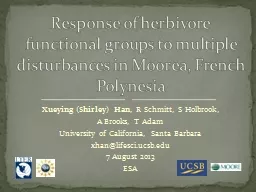

R Schmitt S Holbrook A Brooks T Adam University of California Santa Barbara xhanlifesciucsbedu 7 August 2013 ESA Response of herbivore functional groups to multiple disturbances in Moorea French Polynesia ID: 299014
Download Presentation The PPT/PDF document "Xueying (Shirley) Han" is the property of its rightful owner. Permission is granted to download and print the materials on this web site for personal, non-commercial use only, and to display it on your personal computer provided you do not modify the materials and that you retain all copyright notices contained in the materials. By downloading content from our website, you accept the terms of this agreement.
Slide1
Xueying (Shirley) Han, R Schmitt, S Holbrook, A Brooks, T AdamUniversity of California, Santa Barbaraxhan@lifesci.ucsb.edu7 August 2013ESA
Response of herbivore functional groups to multiple disturbances in Moorea, French PolynesiaSlide2
Background
Disturbances
Ocean acidification
Disease outbreaks Large stormsGlobal warming
Herbivores
Herbivorous fishes and sea urchinsControls macroalgaeCrucial to coral reef systemsSlide3
Moorea, French Polynesia
2008-2009
Acanthaster
planci:Crown-of-thorns starfish (COTS) outbreak
February 2010
Cyclone OliSlide4
ConsequencesDecrease in fore reef coral cover from ~40% to ~3%
Decline in corallivores and coral dwellers
Increase in herbivores
Adam et al. (in prep)Slide5
Study Site: Moorea
Habitats (3): fringing, backreef, and fore reef
Sites (6): LTER1-6Total: 18 sitesAnnual fish surveys: 2006-2012BrowsersDetritivores
ExcavatorsFarmersGrazer/detritivoresScrapersSlide6
Herbivore Functional GroupsBrowser—consumes standing macroalgae(e.g.
Naso lituratus)Slide7
Herbivore Functional GroupsBrowser—consumes standing macroalgae
(e.g. Naso
lituratus)
Detritivore—consumes detritus
(e.g. Ctenochaetus
striatus)Slide8
Herbivore Functional GroupsBrowser—consumes standing macroalgae
(e.g. Naso
lituratus)
Detritivore—consumes detritus
(e.g.
Ctenochaetus striatus)
Excavator—consumes epilithic algal turf and removes large amounts of the calcium carbonate substrata
(e.g. Chlorurus sordidus)Slide9
Herbivore Functional GroupsFarmer—site-attached, territorial species that maintain algal farms(e.g.
Stegastes nigricans)Slide10
Herbivore Functional GroupsFarmer—site-attached, territorial species that maintain algal farms
(e.g. Stegastes
nigricans)
Grazer/detritivore—feeds on epilithic algal turf without scraping/excavating the substratum(e.g. Acanthurus nigrofuscus)Slide11
Herbivore Functional GroupsFarmer—site-attached, territorial species that maintain algal farms
(e.g. Stegastes
nigricans)
Grazer/detritivore—feeds on epilithic algal turf without scraping/excavating the substratum(e.g. Acanthurus
nigrofuscus)
Scraper—consume epilithic algal turf and small portions of the reef substratum(e.g. Scarus
psittacus)Slide12
QuestionsHow did functional groups respond on an island-wide scale?
Are there differences in the functional community assemblage among the three habitats?
Did these habitats respond similarly to the disturbance?Are responses related to the initial biomass of a species?Slide13
Island-wide response of functional groups
Functional groups responded differently in both direction and magnitude.Slide14
Island-wide response of functional groups
Functional group response is not related to pre-disturbance biomass.Slide15
Functional community assemblages among habitats
Habitats have different functional assemblages.
Despite difference, the response among habitats was the same—increased scrapers.Slide16
Are responses related to the initial biomass of a species?
Response is not related to a species’ pre-disturbance biomass.
Browser
DetritivoreExcavatorFarmerGrazer/detritivoreScraperSlide17
SummaryHow did functional groups respond on an island-wide scale?
Herbivore functional groups responded differently
Direction and magnitude of response was not related to the pre-disturbance biomass of a functional groupSlide18
SummaryHow did functional groups respond on an island-wide scale?
Herbivore functional groups responded differently
Direction and magnitude of response was not related to the pre-disturbance biomass of a functional group
Are there differences in the functional community assemblage among the three habitats?Did these habitats respond similarly to the disturbance?
Characteristically different functional assemblages among habitats
All habitats moved towards a community with increased scrapersSlide19
SummaryHow did functional groups respond on an island-wide scale?
Herbivore functional groups responded differently
Direction and magnitude of response was not related to the pre-disturbance biomass of a functional group
Are there differences in the functional community assemblage among the three habitats?Did these habitats respond similarly to the disturbance?
Characteristically different functional assemblages among habitats
All habitats moved towards a community with increased scrapers
Are responses related to the initial biomass of a species?
Differences in post-disturbance response are not related to the initial biomass of a speciesSlide20
Thank you!Questions?xhan@lifesci.ucsb.edu
@xueyinghanSlide21
Outline Background/introduction
Recent dynamics in Moorea, French Polynesia Study site
Herbivore functional groups Research questions How did functional groups respond on an island-wide scale?
Are there differences in the functional community assemblage among the three habitats? Did these habitats respond similarly to the disturbance?Are responses related to the initial biomass of a species?